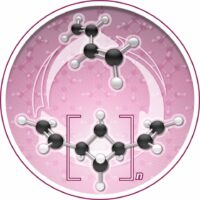By Wendy Plump, Department of Chemistry
As the planet’s burden of rubber and plastic rises unabated, scientists look to the promise of closed-loop recycling to reduce trash. Researchers from Princeton University’s Department of Chemistry have discovered a potentially game-changing new molecule with vast implications for fulfilling that promise.
A team of scientists led by Paul Chirik, the Edwards S. Sanford Professor of Chemistry and an affiliated faculty member of the Andlinger Center, reports in Nature Chemistry that this molecule connects in a very unusual way: as a repeating sequence of squares, which allows the process to go backwards under certain conditions. In other words, the molecule can be “zipped up” to make a new polymer for use in plastic, and then unzipped — depolymerized — back to its pristine state, ready to be used again.
The molecule — formally named oligocyclobutane but casually referred to around the Chirik lab as “the polymer of squares” — could one day enable the use of plastic products many times over, unlike most of today’s plastics that can only be recycled once, if at all.

“I honestly think this work is one of the most important things to ever come out of my lab,” said Chirik, the senior author of the paper. Collaborator Alex Carpenter, a former staff chemist with ExxonMobil Chemical called it “transformative.”
The research is still at an early stage, and the material’s performance attributes have yet to be thoroughly explored. But the Chirik lab has provided a conceptual precedent for a chemical transformation not generally thought practical for certain materials.
In the past, turning a material like this back into its pristine state has been accomplished with expensive, specialized polymers and only after a multitude of steps — and never with a raw material as common as this one. The molecule is a form of polybutadiene, which has been known for over a hundred years and is used to make rubber and plastic products like tires and shoe soles. Butadiene, its parent material, is an abundant organic compound and a major byproduct of fossil fuel development.
“To take a really common chemical that people have been studying and polymerizing for many decades and make a fundamentally new material out of it — let alone have that material have interesting innate properties — not only is that unexpected, it’s really a big step forward,” said Carpenter.
The Chirik lab explores sustainable chemistry by investigating the use of iron to build new molecules. In this particular research, the iron “persuades” the monomers to click together to make the polymer of squares. Normally, monomers connect to form a polymer — which is simply a repeating unit of monomers — through an S-shaped structure often described as looking like spaghetti. But with this new molecule, the monomers zip together in a chain of squaresTo unzip them, the molecule is exposed to a vacuum in the presence of the iron catalyst, which reverses the process and recovers the original material, making this a rare example of closed-loop chemical recycling.

The project stretches back to 2017, when C. Rose Kennedy, then a postdoctoral researcher in the Chirik lab, noticed a viscous liquid accumulating at the bottom of a flask during a reaction. Investigating further, she found evidence that polymerization had taken place.
“It was pretty clear right away how this would be possible to click the monomers together in a different or continuous way,” said Kennedy. “We immediately recognized this could be something potentially extremely valuable.”
Chirik added: “You can make really tough materials out of this monomer. What people tend to assume is that when you have a chemically recyclable polymer, it has to be somehow inherently weak or not durable. We’ve made something that’s really, really tough but is also chemically recyclable. We can get pure monomer back out of it. And that surprised me.”
Megan Mohadjer Beromi, a postdoctoral research fellow in the lab and the paper’s lead author, said the material has other intriguing properties that will form the basis of future research on chemically recyclable materials.
She added: “It’s the coolest thing I’ve ever worked on in my life.”
“Iron Catalyzed Synthesis and Chemical Recycling of Telechelic, 1,3-Enchained Oligocyclobutanes,” is co-authored by Paul Chirik and Megan Mohadjer Beromi of the Chirik Lab; C. Rose Kennedy, formerly of the Chirik Lab; Jarod M. Younker, ExxonMobil Chemical; Alex E. Carpenter, formerly of ExxonMobil Chemical; Sarah J. Mattler, ExxonMobil Chemical; and Joseph A. Throckmorton, ExxonMobil Chemical. The paper appears in the Jan. 25 issue of Nature Chemistry (DOI: 10.1038/s41557-020-00614-w). Initial funding for this work was provided by Firmenich and the National Institutes of Health Ruth L. Kirschstein National Research Service Award (F32 GM134610 & F32 GM126640). Funding was also provided by ExxonMobil through Princeton E-filliates Partnership.
This article has been abridged from a fuller account of the oligocyclobutane’s discovery, available on the Department of Chemistry homepage.